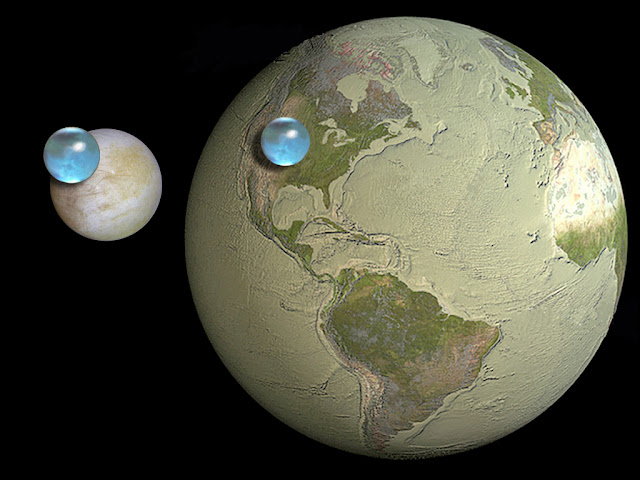Earth → Solar System → Solar Interstellar Neightborhood → Milky Way Galaxy → Local Galactic Group → Virgo Supercluster → Observable Universe → Universe → Unknown (our Universe might be a part of Multiverse)
Earth - 12,700 km in diameter - Our planet
Geospace - 63,000 km Sunward side; - 6,300,000 km trailing side - The space dominated by Earth's magnetic field
Orbit of the Moon - 770,000 km across - The average diameter of the orbit of the Moon relative to the Earth
Earth's Orbit - 300 million km across (2 AU) - The average diameter of the orbit of the Earth relative to the Sun. Contains the Sun, Mercury and Venus
Inner Solar System - 6 AU across - Contains the Sun, the inner planets (Mercury, Venus, Earth and Mars) and the asteroid belt
Outer Solar System - 60 AU across - Surrounds the inner Solar System; comprises the outer planets (Jupiter, Saturn, Uranus and Neptune)
Kuiper Belt - 96 AU across - Belt of icy objects surrounding the outer solar system. Contains the dwarf planets Pluto, Haumea and Makemake
Heliosphere - 160 AU across - Maximum extent of the Solar wind and the interplanetary medium
Scattered Disk - 200 AU across - Region of sparsely scattered icy objects surrounding the Kuiper belt. Contains the dwarf planet Eris
Oort Cloud - 100,000–200,000 AU across (2–4 light-years) - Spherical shell of over a trillion comets
Solar System - 4 light-years across - Our home planetary system. At this point, the Sun's gravity gives way to that of surrounding stars
Local Interstellar Cloud - 30 light-years across - Interstellar cloud of gas through which the Sun and a number of other stars are currently travelling
Local Bubble - 210–815 light-years across - Cavity in the interstellar medium in which our Sun and a number of other stars are currently travelling. Caused by a past supernova
Gould Belt - 3,000 light-years across - Ring of young stars through which our Sun is currently travelling
Orion Arm - 10,000 light-years in length - The spiral arm of the Milky Way Galaxy through which our Sun is currently travelling
Orbit of the Solar System - 56,000 light years across - The average diameter of the orbit of the Sun relative to the Galactic Center. Our Sun's orbital radius is roughly 28,000 light years, or slightly over half way to the galactic edge. One orbital period of our Solar System lasts between 225 and 250 million years
Milky Way Galaxy - 100,000 light-years across - Our home galaxy, composed of 200 billion to 400 billion stars and filled with the interstellar medium
Milky Way Subgroup - 2.74 million light-years across (0.84 megaparsecs) - The Milky Way and those satellite galaxies gravitationally bound to it, such as the Sagittarius Dwarf, the Ursa Minor Dwarf and the Canis Major Dwarf. Cited distance is the orbital diameter of the Leo T Dwarf galaxy, the most distant galaxy in the Milky Way subgroup
Local Group - 3 megaparsecs across - Group of at least 47 galaxies. Dominated by Andromeda Galaxy (the largest), The Milky Way and Triangulum; the remainder are small dwarf galaxies
Virgo Supercluster - 33 megaparsecs across - The supercluster of which our Local Group is a part; comprises roughly 100 galaxy groups and clusters
Pisces-Cetus Supercluster Complex - 300 megaparsecs across - The galaxy filament of which the Virgo Supercluster is a part
Observable Universe - 28,000 megaparsecs across - The large-scale structure of the Universe consists of more than 100 billion galaxies, arranged in millions of superclusters, galactic filaments, and voids, creating a foam-like superstructure
Universe - Minimum of 28,000 megaparsecs - Beyond the observable Universe lies the unobservable regions where no light from those regions has reached the Earth yet. No information is available about the region, as light is the fastest travelling medium of information. However, since there is no reason to suppose different natural laws, the universe is likely to contain more galaxies in the same foam-like superstructure
Beyond - Size Unknown - Our universe might be a part of multiverse, omniverse, and/or other hypothetical concepts
Explanation of units:
- 1 AU or Astronomical Unit is the distance between the Earth and the Sun, or 150 million km. Earth's orbital diameter is twice its orbital radius, or 2 AU
- One light-year is the distance light travels in a year; equivalent to 9.46 trillion km or 63,200 AU
- A parsec is 3.26 light-years
- One megaparsec is equivalent to one million parsecs or 3.26 million light-year
Images Credit: Andrew Z. Colvin
Explanation from: http://en.wikipedia.org




































